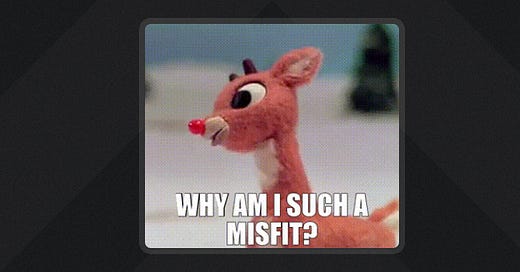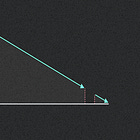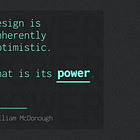Embracing Life as a Creative Technology Misfit
Where is a design technology hybrid supposed to go?
Hello! I’m Pat and Better by Design is my newsletter devoted to bringing more quality creative work into the world. If you’re new here, join 2000+ creative professionals as we uncover new insights each week.
A misfit becomes part of the crowd
I have a confession: I have felt like a misfit for my entire tech career.
Not an imposter, because I always felt confident in my skills, but a misfit, because I never quite fit into the industry status quo.
My first tech job was as a UI developer embedded in a product design team. In this hybrid role, I was responsible for leading the prototyping process by designing with code in the browser alongside a team of talented designers.
I sat right at the intersection of design and technology.
But after 3 fulfilling years as a design engineer, I took stock of my career and confronted two big, structural problems I was bumping into.
Most companies didn’t employ any design engineers, and so by staying in that role, I was limiting my immediate job opportunities.
The career growth trajectory didn’t match my ambition; Companies don’t have Chief Design Technologists.
This left me in a puzzling position.
Staying on my default path meant that I could become a world-class design engineer and still end up not calling the shots for either design or engineering at the apex of my career.
That seemed unappealing, but to conform to the standards in either direction meant giving up something I held dear.
Pursuing engineering would require that I let go of design and build a deeper knowledge of backend software practices. Pursuing design would require that I let go of technical skills in favor of developing a broader design toolkit.
After a long reflection, I recognized that following the engineering path didn’t align as well with my strengths or tolerances, so I leaned into design, built my portfolio, and made the switch.
A misfit became part of the design crowd.
Once a misfit, always a misfit
Seven years later I’m content with my choice, but I can’t shake the feeling that I abandoned a piece of myself in the process.
I’ve had a good run, working my way up from mid-level product designer to senior to principal. And yet, there’s still much more I believe I can offer and more that I’m interested in doing. I suppose the reality is that I’m just a multidisciplinary guy, and so to accept anyone else’s limited definition of what I’m allowed to pursue in my daily work feels like a loss.
These days, while my coding skills are still in a deep freeze, I can’t keep myself away from writing and business which again puts me at odds with many in my field.
From the business side, it’s: “Who does this designer think he is butting in on business strategy?”
From the design side, it’s: “How can this guy call himself a good designer when he’s spending so much time on things that aren’t design?”
Either way, it’s more of the same.
The status quo wants a square peg for a square hole.
But I have always been, and will always be a shape-shifter.
Acceptance
There’s a quote I like from Joshua Fields Millburn that goes:
“You can’t change the people around you, but you can change the people around you”.
In other words, it’s not worth trying to change people who don’t want to change. Instead, go find new people.
I think this nicely sums up my approach to design and business now too.
I’m no longer interested in trying to convince any business to change that doesn’t want to change. If a company doesn’t see the value of enabling good design and supporting multidisciplinary work, that’s their issue, not mine.
Instead, I’ll create my own business and find like-minded people who are interested in operating differently. Together we’ll make space for more successful and more rewarding ways of working from the outset.
This is the emerging era of design entrepreneurship.
We’re not fighting the old status quo; we’re creating a new one in our image.
It’s a new frontier for the polymaths.
A new home for the misfits.
Until next time,
Pat 💚
If you got a little value from this post, consider subscribing, sharing, or following me on Twitter. If you got a lot of value, consider pledging to support my work with a paid subscription in the future.






